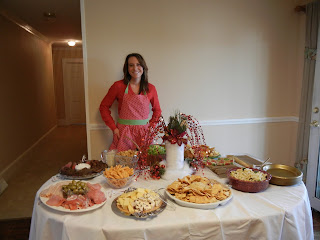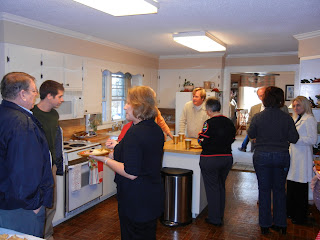Experienced Charlotte, NC Area Residential Designer & Builder. Specialists in Custom New Home Construction and Remodeling/Renovation of Existing Homes. Serving homeowners mainly in Cabarrus, Stanly, Iredell, Mecklenburg and Union Counties.
Thursday, December 29, 2011
Thursday, December 22, 2011
Schultz Custom Homes and Remodeling was glad to lend a helping hand when Extreme Makeover Home Edition came to Lincolnton, NC. We wish the Friday family a VERY MERRY CHRISTMAS and a PROSPEROUS NEW YEAR!

Visit our website!
Labels:
aging in place,
architect,
builder,
cabarrus county,
charlotte,
christmas,
concord,
custom home,
home remodeling,
home renovation,
ipad,
NC,
north carolina
Wednesday, December 14, 2011
Passive Homes... What are They?
ENVIRONMENTALLY friendly and conservation-minded building techniques have been around for decades. But only in recent years have standards, like the LEED certification from the U.S. Green Building Council, been developed for builders to follow.
Any additional energy needs can be generated by renewable sources. The institute says a passive house uses less than a quarter of the energy of a traditionally powered home.
There are about 32,000 passive houses worldwide, most of them in Austria and Germany, according to the institute, which is in Darmstadt, Germany. A number of buildings in New York City are being retrofitted as passive houses, including a multifamily development in Brooklyn at 96 St. Marks Avenue.
“Historically, green homes have fetched a premium,” said Brendan Aguayo, the developer of the St. Marks Avenue house, “and we feel ‘passive house’ is the most tangible type of green home.” Mr. Aguayo, who is working with a development partner, Martin Handler, added, “I’ve seen green homes fetch anywhere from a 5 to 30 percent premium.”
Mr. Aguayo said he did not yet know what the condominiums would cost; they are to be completed in January. Passive-house technology has added about 10 percent to the construction costs, he said.
More multifamily passive-house developments are on the way in New York, including new construction. Marshall Sohne, the president of Passiv House Xperimental, expects to break ground this month on an eight-unit condo building at 138 Sackett Street and a two-unit condo building at 107 Union Street, both in Brooklyn.
Mr. Sohne also intends to start construction next year on an eight-unit rental development nearby at 211-213 Columbia Street. Even though meeting the Passivhaus standards adds 10 to 15 percent to the cost of construction, the resulting low energy costs offset that, Mr. Sohne said.
“The tenant will figure that out,” he said, “and be willing to pay a higher rent for the savings they’ll get on energy and possibly for the improved quality of life they’ll experience. It’s a quieter apartment.”
Passive houses have not yet caught on in this country for a variety of reasons, said Ken Levenson, the architect who designed 96 St. Marks and the president of NY Passive House, an organization that advocates for passive housing and educates professionals in the techniques.
First, Mr. Levenson said, energy costs are much lower in America than in Europe. Also, most of the necessary components are made and sold in Europe and are not available here. Few architects or builders are trained in passive-house techniques, and most homeowners are unfamiliar with the concept.
Doug Mcdonald of Westport, Conn., who has been living in a retrofitted 3,800-square-foot passive house for a year, said it was strikingly different from a traditional home.
“You can feel it the moment the door opens,” Mr. Mcdonald said, explaining that those who have experienced passive houses recognize the feel of the air immediately. “We live in short sleeves and T-shirts year round,” he said. “My house sits at 73 to 74 degrees with relative humidity of about 45 to 50 percent all year round.”
That comfortable living environment is achieved without a furnace or central heating system, and Mr. Mcdonald has no energy bills. “I live in a zero carbon house,” he said. “I consume no gas, no oil, nothing.”
What he does have is a ventilation system, called an energy recovery ventilator, or E.R.V. Simply put, inside air is pulled through the ventilator, and its heat is transferred to membranes; it is cooled and exits as exhaust. Fresh outside air is at the same time being pulled in and is warmed by the membranes that trapped the exhaust heat. The principle is known as counterflow.
Triple-pane windows and 23-inch-thick walls create an airtight home in which Mr. Mcdonald’s family can barely hear any outside noise. And by filtering the air, the ventilator offers an asset unavailable through traditional technology: It keeps carbon dioxide levels low.
“When you wake up after sleeping in a passive house,” Mr. Mcdonald said, “you never have that sort of ‘ugh’ feeling. It’s incredible, because you wake up with the best sleep ever, because it’s incredibly oxygenated air.”
He said the ventilator reduced heating and cooling energy use by about 90 percent. The energy source for the other 10 percent could be a pot of boiling water or a clothes dryer. Or it could be sunlight, as passive houses should be oriented to maximize exposure to the sun’s rays.
Mr. Aguayo, who has installed energy recovery ventilators in the two-bedroom units at 96 St. Marks, acknowledged that with many of the components for passive houses not made in the United States, it costs more to create passive homes.
But that can be offset, he said: “I anticipate that our next retrofit will be considerably less in costs and time, now that we’ve worked out some of the kinks and come up with ways of doing a few things differently.”
The Passivhaus Institut is developing strategies to make the construction of passive houses more efficient and achievable in any climate, said Wolfgang Feist, the director of the institute.
Dr. Feist, who built an early passive house in Darmstadt, in 1991, says that the roots of passive structures go back as far as the 1930s.
One of the more recent areas of the Passivhaus Institut’s research may well be applicable to apartments in New York City. The institute has developed techniques for building cantilevered balconies without creating a “thermal bridge” to the outside that allows heat to escape, Dr. Feist said.
In Europe, the additional cost of building a passive structure is now about 4 percent, Dr. Feist said; in the United States, where overall building costs are lower, it is about 6 percent.
Passivhaus’s energy-use standards are more stringent than those of the U.S. Green Building Council, which issues certifications for Leadership in Energy and Environmental Design, or LEED; or the federal government’s Energy Star for Homes program, Mr. Levenson said.
An Energy Star home might save 15 to 20 percent energy on heating, while under LEED, “it would be considered to be superb if you had 30 percent,” he said.
“So the Passivhaus standards,” Mr. Levenson said, “where you’re talking up to 90 percent reduction in heating and cooling, really changes the whole paradigm.”
Thursday, December 8, 2011
Schultz Custom Homes and Remodeling Incorporates NEW Communication Software
Web Based Home Builder Software for Residential Builders and Remodelers
BuilderTREND provides web-based home builder software to optimize communication between the builders, their customers, vendors, and subcontractors.The BuilderTREND web-based project management software empowers home builders and remodelers to provide a better building experience for their homebuyers, associates, and subcontractors. The system provides real-time 24/7 access to scheduling information, change orders, documents, photos, warranty management, homebuyer selections, and much more.
There is no software to install, a login is placed directly on the home builder's website and the system itself is even branded to their custom look. Automatic notifications help builders manage their communication and operations while providing their satisfied homebuyers with a better building experience.
Here at Schultz Custom Homes and Remodeling, we are proud to be implementing this new computer software into our company. We feel that it will allow our clients to be more involved and aware of the status of their projects at any given time.
Labels:
architect,
builder,
cabarrus county,
charlotte,
christmas,
concord,
construction,
custom home,
design,
general contractor,
home remodeling,
home renovation,
ipad,
NC,
north carolina
Wednesday, December 7, 2011
Monday, November 28, 2011
Wednesday, November 9, 2011
What We Stand For....
To Create an exceptional building experience for our clients,
So that we may Grow by making a fair return for our efforts.
Core Values
Trustworthy
by being realistic, transparent, practical, rational and level headed.
Respectful
of another's property, time, capital, resources, the environment and the community.
Conscientious
of creating value by being productive and efficient using wisdom to make sound judgment.
Accountable
to our clients, coworkers and community by living ethically and with integrity.
Attentive
to effective communication making sure of being understood while understanding others.
Reflective
of our work, effectiveness, procedures and personality to inspire continuous improvement.
Our core values govern how we fulfill our mission statement.
Custom Home Testimonial... hear what Randy has to say about Schultz Custom Homes and Remodeling!
Labels:
cabarrus county,
charlotte,
christmas,
concord,
construction,
custom home,
general contractor,
harrisburg,
holidays,
home remodeling,
ipad,
NC,
north carolina
Monday, November 7, 2011
Harriet's Story: Kitchen Remodel by Schultz Custom Homes and Remodeling
Harriet Dalrymple’s kitchen provides a perfect example of a situation in which we changed and redefined a living space.
Harriet had recently lost her husband before we met, and was understandably devastated by the loss. The two of them had always talked about remodeling their kitchen which they felt was an outdated and dysfunctional. After her husband died, Harriet decided that it was time for change.
Upon our first meeting, we listened to Harriet. What we sensed was that there seemed to be a disconnect between her and the rest of her family when she cooks. This disconnect caused her frustration because cooking was special to her.
As is common in older homes, Harriet’s kitchen was enclosed by four walls, separating the space from the rest of the home. Through active listening, we were able to isolate the root of Harriet’s frustrations. Simply stated, the current kitchen design was competing with her two passions in life: cooking and engaging with family.
Having a grasp on Harriet’s needs, we were able to redefine the space by removing the wall separating the kitchen from the living room. We added an island featuring a flat cook-top facing the living room with a pop-up hood vent. These changes now create an open floor-plan for Harriet to cook in and be with her family. Harriet felt satisfied because we listened and now her home works for her lifestyle.
REMEMBERING OUR DEAR FRIEND HARRIET DALRYMPLE
2/26/1950-4/8/2010
Labels:
builder,
cabarrus county,
charlotte,
christmas,
concord,
construction,
custom,
custom home,
design,
general contractor,
harrisburg,
home remodeling,
home renovation,
ipad,
NC,
north carolina
Subscribe to:
Posts (Atom)




















































